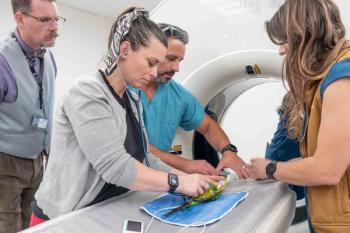
Interpreting contrast studies (Proceedings)
Radiographic interpretation is a learned skill. Interpretation errors can be divided into two categories. There are errors of omission and errors of interpretation.
Radiographic interpretation is a learned skill. Interpretation errors can be divided into 2 categories. There are errors of omission and errors of interpretation. Errors of omission are failing to identify a lesion while errors of interpretation are usually due to a lack of experience or a lack of knowledge. Errors of omission can be avoided by taking a systematic approach to reading radiographs. However errors of interpretation are more difficult to overcome and require time and study.
Reducing radiographic interpretation errors requires the clinician to adhere to beneficial habits and avoid bad ones. Some of the bad habits in film reading are the "Aunt Minnie" approach which is to identify something on a radiograph and decide that this finding must be one thing because it has a similar appearance to a known diagnosis from a past experience. The "Aunt Minnie" approach to radiographs does not work because the body has a finite number of ways to respond to a disease and therefore multiple different disease processes can result in a similar appearance on radiographs. A second common interpretation error is for the reviewer to see what they want to see to fit a preconceived diagnosis. Lastly, reviewers may become overwhelmed by the radiographic findings and become distracted by an obvious but unimportant radiographic finding.
The reviewer should always keep in mind the clinical question they are trying to answer such as "Why is this patient dyspneic?" or "why is this patient vomiting". This approach has been coined "Telling the story" and it remains an integral part of proper film reading. When "telling the story" the radiographic findings should correlate to the clinical picture and follow a logical thought process as to cause and effect. While "telling the story" will not ensure a correct diagnosis, a plausible story has a far better chance at being correct than a non-plausible or zebra diagnosis.
To "tell the story" there are 5 steps. 1) Evaluate the signalment, history, clinical signs and bloodwork. 2) Make a most likely to least likely list of plausible differentials. Try to have a minimum of 3 differentials. 3) Evaluate the radiographs for evidence that would support or refute your differentials. 4) Evaluate the remainder of the radiograph for other findings. 5) Tell the most plausible story which relates your radiographic findings to the clinical signs.
One of the keys to evaluating contrast studies is to ensure that the study is performed correctly. Inappropriate contrast dosing and radiograph timing are the two most common mistakes when performing contrast studies.
Barium Esophagram
Uses: Esophageal foreign bodies, suspected hiatal hernia, strictures, masses, leaks and diverticuli.
Keys to remember: 1) Use iodinated contrast and don't give kibble if perforation is suspected 2) Use fluoroscopy if static esophagram is unclear or evaluating for achlasia 3) Use barium paste when evaluating for a foreign body or mass 4) Include both liquid and barium soaked kibble 5) take multiple radiographs to confirm a finding 6) Always include both lateral and V/D 7) Make sure radiographs are true lateral, V/D or close to15- 30 degrees off V/D if intentional. 8) Include neck 9) Cat has normal herring bone appearance 10) Avoid sedation and anesthesia 11) Barium aspiration is usually of no clinical significance 12) Perform multiple swallows
Iodinated Contrast Esophagram: Uses: If esophageal perforation is suspected use iodinated contrast first then follow with barium. Use non-ionic contrast when possible.
1) Use 50:50 mixture of contrast and water 2) Don't give kibble if perforation is suspected. 3) Use iodinated contrast if scoping is to follow
Evaluate esophagus for: 1) displacement 2) mucosal irregularity 3) leakage 4) repeatable filling defect
Upper GI
Barium Upper GI
Uses: foreign bodies, ulcers, hernias, GI masses, transit times, unexplained weight loss or in patients with hematemesis or melena.
Keys to remember: 1) Prepare the patient. Empty stomach. Empty colon 2) No food mixed with barium since food affects gastric emptying. 3) No anesthesia. Sedation with acepromazine or ket-val ok. 4) Use iodinated contrast if perforation is suspected. 5) No place for BIPS 6) Keep radiographing until contrast hits colon or surgical diagnosis is made. 7) Always include both lateral and V/D for each time 8) Left lateral to evaluate the pylorus 9)Always have time markers 10) Residual barium coating the stomach is ok
Iodinated Contrast Upper GI: Uses: If GI perforation is suspected used iodinated contrast. Use non-ionic contrast when possible. Faster sequence due to faster transit time. Rads every 15 minutes.
Cat- 600-800 mgI/kg diluted with water to 10 ml/kg
Dog- 700-875 mgI/kg diluted with water to 10 ml/kg
Evaluate GI tract for: 1) Transit time. Gastric and SI transit 30-120 minutes (dog). Gastric and SI transit time 15-60 minutes (cat). 2) Bowel irregularity 3) Bowel persisting in same place (adhesions) 4) Ulcers 5) Obstructions 6) Retained barium (foreign body) 7) Leakage 8) Repeatable filling defect
Pneumocolon
Uses: Differentiate small bowel from colon.
Keys to remember: 1) Fast. 2) Easy. Use ear bulb or syringe with red rubber tubing. 3) Place patient in right lateral unless thee is a portosystemic shunt then use left lateral in case of air embolism. 4) Add more air if there is not enough
Cat- 20-30 ml air total
Dog- 1-3 ml/kg
Peritoneogram
Uses: Evaluate for the presence of a diaphragmatic hernia.
Keys to remember: 1) Obtain survey right lateral and V/D projections which include the caudal thorax and cranial abdomen. 2) Aseptically inject 1.1-2.2 ml of non-ionic iodinated contrast into the peritoneal cavity. If ascites is present use the higher dosage. 3) Aspirate prior to injection to ensure not in a viscus structure. 4) Wheelbarrow the patient for 5 minutes after injection. 5) Hypovolemia and contrast hypersensitivity are contraindications.
Newsletter
From exam room tips to practice management insights, get trusted veterinary news delivered straight to your inbox—subscribe to dvm360.






